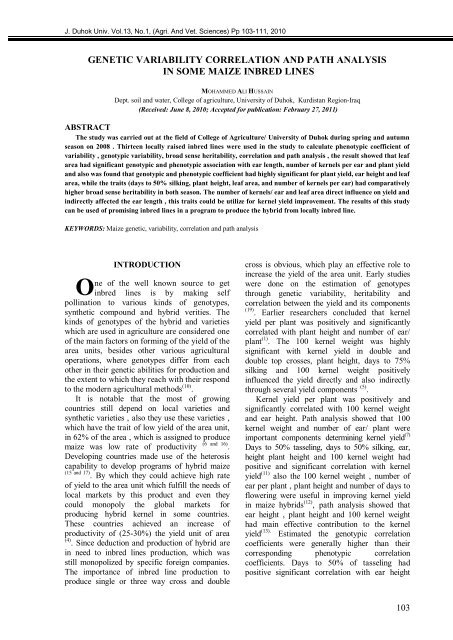The Influence Of Priming Two Cucumber Cultivar Seeds
The Influence Of Priming Two Cucumber Cultivar Seeds
The Influence Of Priming Two Cucumber Cultivar Seeds
You also want an ePaper? Increase the reach of your titles
YUMPU automatically turns print PDFs into web optimized ePapers that Google loves.
J. Duhok Univ. Vol.13, No.1, (Agri. And Vet. Sciences) Pp 103-111, 2010<br />
GENETIC VARIABILITY CORRELATION AND PATH ANALYSIS<br />
IN SOME MAIZE INBRED LINES<br />
MOHAMMED ALI HUSSAIN<br />
Dept. soil and water, College of agriculture, University of Duhok, Kurdistan Region-Iraq<br />
(Received: June 8, 2010; Accepted for publication: February 27, 2011)<br />
ABSTRACT<br />
<strong>The</strong> study was carried out at the field of College of Agriculture/ University of Duhok during spring and autumn<br />
season on 2008 . Thirteen locally raised inbred lines were used in the study to calculate phenotypic coefficient of<br />
variability , genotypic variability, broad sense heritability, correlation and path analysis , the result showed that leaf<br />
area had significant genotypic and phenotypic association with ear length, number of kernels per ear and plant yield<br />
and also was found that genotypic and phenotypic coefficient had highly significant for plant yield, ear height and leaf<br />
area, while the traits (days to 50% silking, plant height, leaf area, and number of kernels per ear) had comparatively<br />
higher broad sense heritability in both season. <strong>The</strong> number of kernels/ ear and leaf area direct influence on yield and<br />
indirectly affected the ear length , this traits could be utilize for kernel yield improvement. <strong>The</strong> results of this study<br />
can be used of promising inbred lines in a program to produce the hybrid from locally inbred line.<br />
KEYWORDS: Maize genetic, variability, correlation and path analysis<br />
O<br />
INTRODUCTION<br />
ne of the well known source to get<br />
inbred lines is by making self<br />
pollination to various kinds of genotypes,<br />
synthetic compound and hybrid verities. <strong>The</strong><br />
kinds of genotypes of the hybrid and varieties<br />
which are used in agriculture are considered one<br />
of the main factors on forming of the yield of the<br />
area units, besides other various agricultural<br />
operations, where genotypes differ from each<br />
other in their genetic abilities for production and<br />
the extent to which they reach with their respond<br />
to the modern agricultural methods (10) .<br />
It is notable that the most of growing<br />
countries still depend on local varieties and<br />
synthetic varieties , also they use these varieties ,<br />
which have the trait of low yield of the area unit,<br />
in 62% of the area , which is assigned to produce<br />
maize was low rate of productivity (6 and 16) .<br />
Developing countries made use of the heterosis<br />
capability to develop programs of hybrid maize<br />
(15 and 17)<br />
. By which they could achieve high rate<br />
of yield to the area unit which fulfill the needs of<br />
local markets by this product and even they<br />
could monopoly the global markets for<br />
producing hybrid kernel in some countries.<br />
<strong>The</strong>se countries achieved an increase of<br />
productivity of (25-30%) the yield unit of area<br />
(4)<br />
. Since deduction and production of hybrid are<br />
in need to inbred lines production, which was<br />
still monopolized by specific foreign companies.<br />
<strong>The</strong> importance of inbred line production to<br />
produce single or three way cross and double<br />
cross is obvious, which play an effective role to<br />
increase the yield of the area unit. Early studies<br />
were done on the estimation of genotypes<br />
through genetic variability, heritability and<br />
correlation between the yield and its components<br />
(19) . Earlier researchers concluded that kernel<br />
yield per plant was positively and significantly<br />
correlated with plant height and number of ear/<br />
plant (1) . <strong>The</strong> 100 kernel weight was highly<br />
significant with kernel yield in double and<br />
double top crosses, plant height, days to 75%<br />
silking and 100 kernel weight positively<br />
influenced the yield directly and also indirectly<br />
through several yield components (5) .<br />
Kernel yield per plant was positively and<br />
significantly correlated with 100 kernel weight<br />
and ear height. Path analysis showed that 100<br />
kernel weight and number of ear/ plant were<br />
important components determining kernel yield (7)<br />
Days to 50% tasseling, days to 50% silking, ear,<br />
height plant height and 100 kernel weight had<br />
positive and significant correlation with kernel<br />
yield (11) also the 100 kernel weight , number of<br />
ear per plant , plant height and number of days to<br />
flowering were useful in improving kernel yield<br />
in maize hybrids (12) , path analysis showed that<br />
ear height , plant height and 100 kernel weight<br />
had main effective contribution to the kernel<br />
yield (13). Estimated the genotypic correlation<br />
coefficients were generally higher than their<br />
corresponding phenotypic correlation<br />
coefficients. Days to 50% of tasseling had<br />
positive significant correlation with ear height<br />
301



